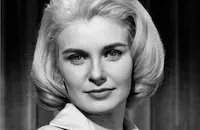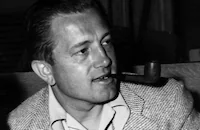The Big Show
Brief Synopsis
Cast & Crew
Spyros P. Skouras
Buddy Adler
Darryl F. Zanuck
Henry King
David O. Selznick
Jerry Wald
Film Details
Technical Specs

Synopsis
Spyros P. Skouras, president of Twentieth Century-Fox Film Corp., welcomes the audience in a seven-minute talk during which he extols the fifty-five films his company intends to release during the next twelve months. Skouras then introduces production chief Buddy Adler, who explains that thirty of the films will be made under his supervision while Robert L. Lippert will produce twenty-five "Showmanship" pictures. Adler then narrates aerial footage of the the studio's back lot and standing sets. Next, Adler introduces Darryl F. Zanuck, former studio head and now an independent producer, who addresses the audience from a set in a London studio where he has just started production of The Sun Also Rises , directed by Henry King, who is seen on location in Mexico. Zanuck then presents extensive clips from his recently completed film Island in the Sun , and announces he has acquired the rights to three recently published books: Compulsion , The Day Christ Died [unproduced] and Koba--The Criminal Years of Joseph Stalin [unproduced].
Adler then introduces David O. Selznick, who talks from a location in the Alps for A Farewell to Arms and announces that he is preparing Tender Is the Night and Mary Magdalene [unproduced]. Producer Jerry Wald then introduces Stanley Donen and they discuss their upcoming production Kiss Them for Me , starring Cary Grant. Grant, Deborah Kerr and Leo McCarey are then seen on the set of An Affair to Remember . After clips of the film are shown, Adler introduces Richard Rogers and Oscar Hammerstein II, who speak about South Pacific . Elia Kazan states he will be making a film from the novel Mud on the Stars [a partial source for Wild River ] and independent producer Henry Ginsberg announces that he will be making five films with Rock Hudson. Director Fred Zinnemann is seen in an editing room and, with the help of assistant editor Jack Holmes, introduces extensive scenes from the black-and-white film A Hatful of Rain . Other black-and-white films are featured as director Victor Vicas introduces scenes from The Wayward Bus and director Nunnally Johnson, Joanne Woodward and Lee J. Cobb are shown on the set of The Three Faces of Eve , then present extracts from the film. Producer David Weisbart and director Robert Webb talk briefly on a recording stage about Way to the Gold , after which Alfred Newman is seen conducting the studio orchestra in a recording of the Twentieth Century-Fox CinemaScope logo fanfare.
In a color sequence shot on the back lot, director Philip Dunne and producer Charles Brackett briefly promote their upcoming film Ten North Frederick , which is to star Spencer Tracy [the completed film starred Gary Cooper.] Producer Walter Reisch and director Richard L. Breen announce that they will film Stopover Tokyo . Robert Buckner talks about his preparations for filming The Hell Bent Kid [released as From Hell to Texas .] Former Movietone News executive Anthony Muto states that he will produce Bombers High [unproduced]. In the studio's wardrobe department, actress Barbara Rush and designer Charles LeMaire introduce scenes from the Richard Burton and Joan Collins film Sea Wife .
Adler then introduces producer Henry Ephron and director Walter Lang, who show clips from Desk Set . Producer Al Lichtman and director Edward Dymtryk announce their forthcoming production of The Young Lions , starring Marlon Brando. In the studio's art department, producer Herbert Bayard Swope, Jr. and Lyle Wheeler go over set designs for The Bravados , then director Henry Koster discusses preparations for the filming of Fräulein . After Frank Tashlin is seen directing a sequence for Will Success Spoil Rock Hunter? clips from the film are shown. Producer/director Dick Powell and writer Richard Murphy examine model planes as they discuss plans for The Hunters , after which Powell meets writer Wendell Mayes at the studio's miniature tank, where scenes for The Enemy Below will be shot. Director Jean Negulesco talks briefly about his forthcoming film A Certain Smile . In a studio projection room, producer Samuel G. Engel introduces scenes from Boy on a Dolphin , then moves to Sound Stage 11, where Henry Levin is shooting senes for Bernardine with Janet Gaynor, Pat Boone, Dick Sargent and Terry Moore.
On camera, Buddy Adler then presents very brief, one shot "portraits" of established Fox actors and actresses in scenes from their films. Thereafter, in material shot specifically for The Big Show , Adler introduces a parade of new talent from the studio's dramatic school: Joanne Woodward, May Britt, Kendall Scott, Tami Conner, Anne Marie Duringer, Al Hedison, Lili Gentle, Linc Foster, Diane Jergens, Tony Franciosa, Elena Murray, Rachel Stephens, Rick Jason, Patricia Powell, Dolores Michaels, Tommy Sands, Patricia Owens and Pat Boone. Adler promises thirty-five major releases for 1958, then moves in front of a large wall chart bearing 27 titles of films planned for production. As he mentions certain pictures, individual title cards appear on screen for upcoming Fox productions, such as Can-Can , Tender Is the Night and The Diary of Anne Frank . [Other titles, such as Jean Christophe and The Wandering Jew , were not produced.]
Adler then introduces Fox general sales manager Alex Harrison and Charles Einfeld, vice-president in charge of advertising and publicity, who promise exhibitors full promotional support. Finally, Skouras encourages exhibitors to support the upcoming releases.

Cast
Spyros P. Skouras

Buddy Adler

Darryl F. Zanuck
Henry King

David O. Selznick
Jerry Wald

Stanley Donen

Cary Grant

Deborah Kerr

Leo Mccarey
Richard Rogers
Oscar Hammerstein Ii

Elia Kazan
Henry Ginsberg

Fred Zinnemann
Jack Holmes
Victor Vicas

Nunnally Johnson

Joanne Woodward

Lee J. Cobb
David Weisbart
Robert Webb

Alfred Newman
Charles Brackett
Philip Dunne
Walter Reisch
Richard L. Breen
Robert Buckner
Anthony Muto

Barbara Rush
Charles Lemaire
Henry Ephron

Walter Lang
Al Lichtman

Edward Dmytryk
Herbert Bayard Swope Jr.
Lyle Wheeler

Henry Koster
Frank Tashlin

Dick Powell
Richard Murphy
Wendell Mayes

Jean Negulesco
Samuel G. Engel

Henry Levin

Janet Gaynor

Pat Boone
Dick Sargent

Terry Moore
May Britt
Kendall Scott
Tami Conner
Anne Marie Duringer
Al Hedison
Lili Gentle
Linc Foster

Diane Jergens

Tony Franciosa
Elena Murray
Rachel Stephens

Rick Jason
Patricia Powell
Dolores Michaels

Tommy Sands

Patricia Owens
Alex Harrison
S. Charles Einfeld

Film Details
Technical Specs

Quotes
Trivia
Notes
There were no production credits given for The Big Show. Although the film was intended primarily for exhibitors, a Film Daily news item of May 7, 1957 reported that Twentieth Century-Fox had also invited prominent civic, social and religious leaders to the various screenings. In addition to the six screenings on May 8, 1957, the picture was exhibited in more than thirty other cities in the U.S. and Canada during that month. While a few of the films seen in The Big Show were represented by sequences from the final release versions, most were still in production and were represented by rejected takes and angles different than those in the released films. The editing of these sequences was frequently different from the release versions, and many had temporary music scores borrowed from other Fox films.
The Twentieth Century-Fox Produced Scripts Collection, located in the UCLA Arts-Special Collections Library, contains a post-production continuity for a later version of the film that was to be shown in Britain. That version is virtually identical to the American version with the exception of the addition of sequences from Heaven Knows, Mr. Allison and The Way to the Gold and the substitution of Murray Silverstone, President of Twentieth Century-Fox International, for Alex Harrison and Charles Einfeld at the film's conclusion. Studio records also include a September 1957 post-production continuity for a 57-minute version prepared for general theater audiences. This version, which opened in San Francisco on August 30, 1957, eliminated much of the material in the 110-minute version, but added sequences from Kiss Them for Me, Peyton Place and The Enemy Below. Additionally, Jeffrey Hunter introduced scenes from No Down Payment. The following performers were added to the "Parade of New Talent" sequence in the shorter version: Diane Varsi, Christine Carere, Lee Philips and Suzy Parker. No sales personnel are seen in the short version, which ends with Buddy Adler stating that he is glad "to have had the chance to talk personally with you, our audience....There's no better entertainment than you can find right in the movie theater."
In 2000, a DVD release of a television program called 20th Century Fox: The First 50 Years also included a version of The Big Show which ran eighty minutes and was assembled from both the long and short versions of the film.
.












